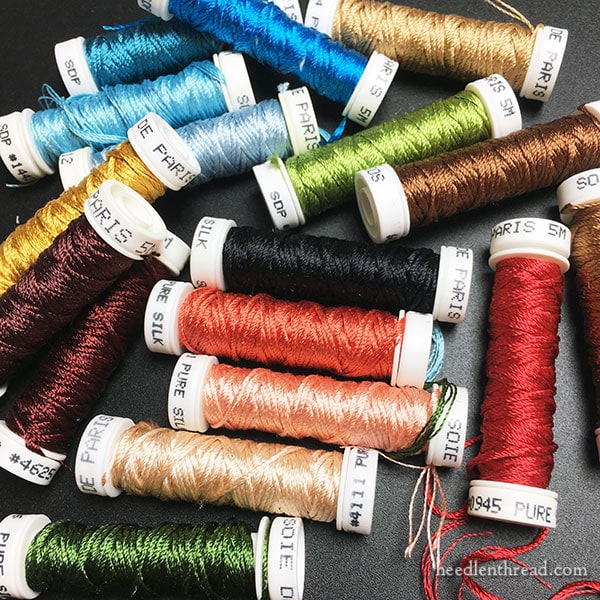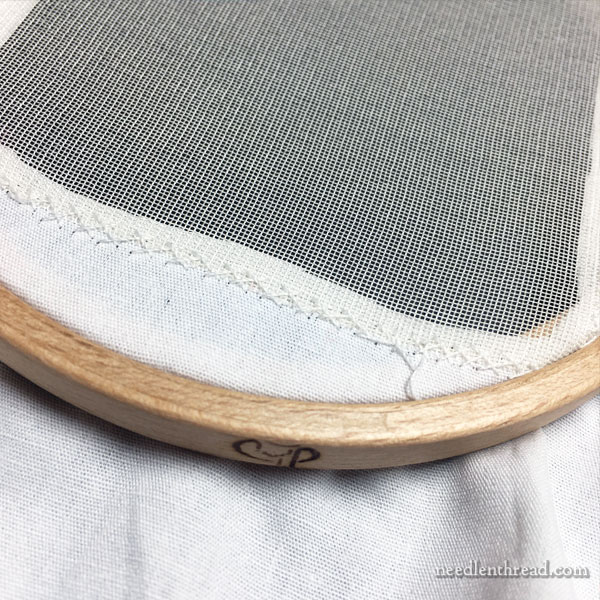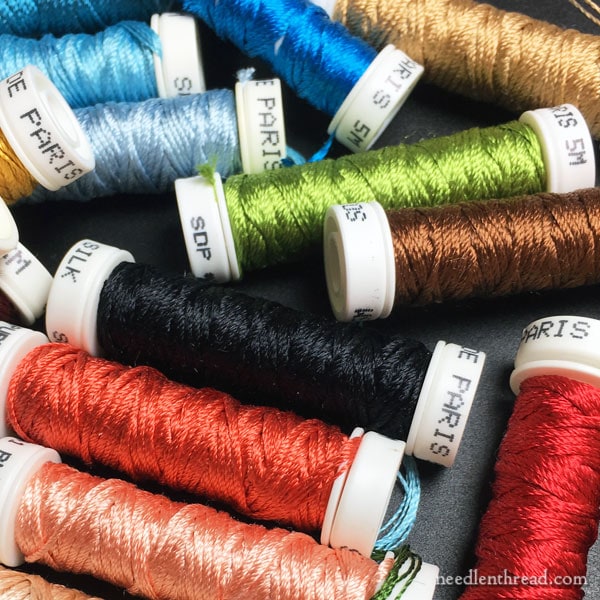Playing with threads and deciding on colors makes me happy.
It’s not just because I like embroidery thread and I like color. It’s more than that!
When I get to the point of selecting colors and threads for a new project, I know that I’m on the brink of a new adventure.
Since thread selection, for me, is often the last part of the whole designing and planning process, I’m always in a state of excitement when the threads are gathered before me!

This weekend, I designed a project that’s been simmering in the back of my brain for quite a while.
Getting an Idea Out of Your Head
I knew that, if I didn’t sit down and actually do it – get the design out of my head and set the project up and gather all the supplies – it would keep bugging me and bugging me and bugging me until I did do it.
This is one of those projects that wakes me up in the middle of the night and then keeps me awake while I think about it… and think about it… and think about it.
It’s been hovering on my mind since last year, in fact. I’ve written notes on it, I’ve doodled ideas for it. But I haven’t bothered to actually tackle the designing and gathering. There are just too many other projects going on!
But now there was nothing for it. I had to sit down and get it out of my head.
Designing on the Computer
Especially if I’m planning a piece of surface embroidery, I start on paper. But this particular project isn’t free style surface embroidery. It’s actually counted work, for 48 count silk gauze.
It’s not a super original design, by the way. Similar designs have been done before! As you will see when I show it to you, it’s certainly not “new” in design concept. What I’m working towards is a different finishing concept.
So I sat at my computer to do the design stuff. I use a program called MacStitch by Ursa Software (which I wrote about here) when playing with counted designs. It works well for my needs and it’s quite affordable.
Setting Up the Fabric
Once my design was satisfactory (though I won’t really know exactly how satisfactory it is, until I stitch it the first time), I set up my fabric by stitching a piece of silk gauze to a larger piece of cotton muslin.

Normally, I’d do that by machine, but I don’t have a machine in my studio. Instead, I used herringbone stitch and sewing thread to stitch the silk gauze into place.
I’ve written about the process of setting up silk gauze for stitching here. The reason for doing this is that it gives you excess (and less expensive) fabric for hooping or framing up the silk gauze, so that you can keep it under good tension while stitching.
I prefer this method to taping silk gauze to a piece of mat board and holding it in your hand. With mat board, there’s just not a lot to grip onto, and the gauze doesn’t remain taut.
If I can get my paws on a pair of stretcher bar frames that are small enough, I’m going to put the piece up on stretcher bars rather than in a hoop. With counted work, I find that stretcher bars and a floor stand are the way to go, so that both hands can easily be used for stitching. With one hand above the work and one hand below, the stitching process is much more efficient.
Gathering the Threads
Finally, the last step – gathering threads!

I’m using one strand of Soie de Paris by Au Ver a Soie for stitching. You can learn more about Soie de Paris in this article here, which includes tips for stitching with it.
I pulled all the colors I think will work with my design. As I stitch, I might make some adjustments. Once I’ve solidified the color choices, I’ll go back to the computer and write the threads and numbers in, so that there’s an accurate color key for the chart.
So that was my Sunday Afternoon Project! Everything for the project is gathered together in a small tray, ready to grab when I can finally sit down and start stitching on it.
Now I can get back to other, more pressing work, without the planning part of this project constantly nagging me.
But you do realize what’s going to happen, right?
Now I’m going to wake up at night and think about stitching the project. And until I start, I won’t have a decent night’s sleep!
I suppose there’s only one thing for it…







Dear Mary,
I do so enjoy reading about your stitching dilemmas! Your honesty and humor makes me chuckle… and makes me wonder if you can read my mind! I always have feelings of anticipation and adventure when I open your emails.
You are as talented as a writer, as you are a stitcher and a teacher. Please write, stitch, and teach on!
With appreciation,
Liz
Northern Illinois
This… is usually the part where I start crying. Why, oh why, are there so many shades of pink?
LOL! That’s how I felt about brown with this one!
Dear Mary
I know what you mean when I get a new idea about a piece of embroidery I won’t rest until I have set it up and to started it. This looks like an interesting project, I can’t wait to see what you are stitching. Good luck with Soie de Paris thread I find they can be difficult to work with. Just out of interest how do you start and end threads on silk gauze which has large holes. Thanks for sharing with us your latest project and for the tips on counted work. Good luck look forward to your progress on this project.
Regards Anita Simmance
Hi, Anita!! I usually use a waste knot on the front and stitch towards it, covering the thread on the back to secure it, and then snipping the knot. I’ve not worked with silk gauze with holes larger than 40 hpi (holes per inch), so that’s always worked for me.
Dear Mary
Thanks for your reply a good idea to use a waste know on the front then it doesn’t show. Looking forward to your progress.
Regards Anita Simmance
Oh, okay, Mary. You are assembling your thread choices for the project. When I saw “gathering” I thought perhaps you were making little puckers — like that 7th grade skirt we made in sewing class? Okay, gather away and enjoy every step. I wait to see what you’re up to. Happy fall season!
I too thought of that sort of gathering and wondered what sort of embroidery would be discussed.
There’s just a certain excitement in starting a new project & my favorite part is sorting & choosing the threads! I have on occasion seen beautiful threads & decided to choose the project that would compliment the threads. Really I think I could happily sort threads all day long! Looking forward to seeing your new project.
Hi Mary!
This may sound like an ignorant question but…are these spools of thread in the photo the equivalent to skeins of thread? Can you separate the thread and use just the number of thread you want? What exactly is the difference? Sorry to bother you with trivial questions! Best wishes, Michele.
Hi, Michele – well, pretty much, yes. With this particular silk thread (Soie de Paris), the thread is stranded, similar to cotton floss, and you can use one or more strands in the needle at one time. They don’t handle quite the same, since they’re filament silk, but they sure are worth the effort of stitching with them – they’re beautiful threads!